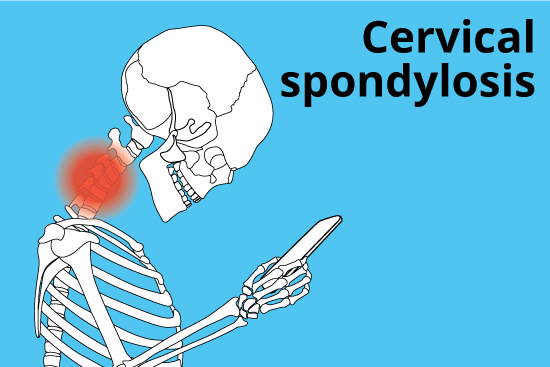CERVICAL SPONDYLOSIS
This term is related to age-related wear and tear affecting the spinal disks in your neck. As the spinal disks dehydrate and shrink, signs of osteoarthritis develop including bony projections along the edges of bones (bone spurs).
This condition is very common and worsens with age. More than 85% of people older than age 60 are affected.

Most people don’t experience any symptoms from these problems. When the symptoms do occur, nonsurgical treatments often are effective.
What causes cervical spondylosis?
Possible causes of the condition include:
- Bone spurs: These overgrowths of bone are the result of extra bone growth to make the spine stronger. But, the extra bone can press on delicate areas of the spine such as the spinal cord and nerves that result in pain.
- Dehydrated spinal disks: The gel-like material inside the disks between spinal bones can dry out over time. This causes bones to rub together more which can be painful.
- Herniated disks: Cracks that allow leakage of the internal cushioning material may develop. This material can press on the spinal cord and nerves resulting in symptoms such as arm numbness and sciatica.
- Injury: Injury to your neck such as during a fall or car accident can accelerate the aging process.
- Ligament Stiffness: Tough cords that connect your spinal bones to each other can become stiffer over time. This affects your neck movement and makes the neck feel tight.
- Overuse: Certain occupations or hobbies involve repetitive movements or heavy lifting like construction work. This can put extra pressure on the spine and result in early wear and tear.
SYMPTOMS OF CERVICAL SPONDYLOSIS
Most people don’t have significant symptoms. When symptoms do occur, they can range from mild to severe and may develop gradually or occur suddenly.
A common symptom is pain around the shoulder blade. Patients will complain of pain along the arm and in the fingers. Pain might increase when:
- Standing
- Sitting
- Sneezing
- Coughing
- Tilting your neck backward
Another common symptom is weakness of muscle. It makes it hard to lift the arms or grasp objects firmly.
Other common signs:
- A stiff neck that becomes worse
- Headaches (mostly occur in the back of the head)
- Tingling or numbness (mainly affects shoulders and arms, although it can also occur in the legs)
Symptoms that occur less frequently normally include a loss of balance and a loss of bladder or bowel control. These symptoms require immediate medical attention.
TREATMENT OPTIONS AVAILABLE FOR CERVICAL SPONDYLOSIS
Treatment depends on the severity of your signs and symptoms. The goal of treatment is to relieve pain, maintain your usual activities as much as possible and prevent permanent injury to the spinal cord and nerves.
Medications
Your doctor might prescribe stronger medications if over-the-counter pain relievers don’t help:
- Nonsteroidal anti-inflammatory drugs: Prescription-strength ibuprofen (Ibuprofen) or naproxen sodium (Anaprox, Anaprox DS) might be required to relieve pain and inflammation.
- Corticosteroids: Oral medications like prednisone can help ease pain. If pain is severe, steroid injections might be required.
- Muscle relaxants: Certain drugs like cyclobenzaprine (Amrix, Fexmid) and methocarbamol (Robaxin) may help to relieve muscle spasms in the neck.
- Anti-seizure medications: Some epilepsy medications like gabapentin (Neurontin) and pregabalin (Lyrica) can dull the pain of damaged nerves.
- Antidepressants: Some antidepressant medications have been found to help ease neck pain from cervical spondylosis.
- Prescription pain relievers: Oxycodone (Percocet, Roxicet) might be prescribed.
Therapy
Exercises to help stretch and strengthen the muscles in your neck and shoulders will be taught by physical therapist. Some people benefit from the use of traction which can help provide more space within the spine if nerve roots are pinched.
Acupuncture
Acupuncture might be recommended to reduce your pain. It’s best provided by a licensed acupuncture practitioner.
Surgery
If conservative treatment doesn’t work or if your neurological signs and symptoms such as weakness in your arms or legs worsen, you may require surgery to create more room for your spinal cord and nerve roots.
Surgery might involve:
- Removing a herniated disk or bone spurs
- Removing part of a vertebra
- Fusing a segment of the neck using bone graft and hardware
DIAGNOSING CERVICAL SPONDYLOSIS
- Consult with doctor and physical exam: Several questions regarding your symptoms will be asked. Then, a set of tests will be conducted. Typical exams include testing your reflexes, checking for muscle weakness or sensory deficits and testing the range of motion of your neck. How you walk may also be examined. All of these tests help your doctor to determine if your nerves and spinal cord are under too much pressure.
Imaging tests provide detailed information to guide diagnosis and treatment. These tested might be recommended:
- Neck X-ray: Show abnormalities such as bone spurs. This indicates cervical spondylosis. It can also rule out rare and more serious causes for neck pain and stiffness like tumors, infections or fractures.
- CT scan: Provide more detailed imaging particularly of bones.
- MRI: Help to pinpoint areas where nerves might be pinched.
- Myelograpy: To provide more detailed X-ray or CT imaging, a tracer dye is injected into the spinal canal.
To determine if nerve signals are traveling properly to your muscles, nerve function tests may be recommended. They are:
- Electromyography (EMG): To measure the electrical activity in your nerves as they transmit messages to your muscles and when they’re at rest.
- Nerve conduction study: Electrodes are attached to the skin above the nerve to be studied. To measure the strength and speed of nerve signals, a small shock is passed through the nerve


